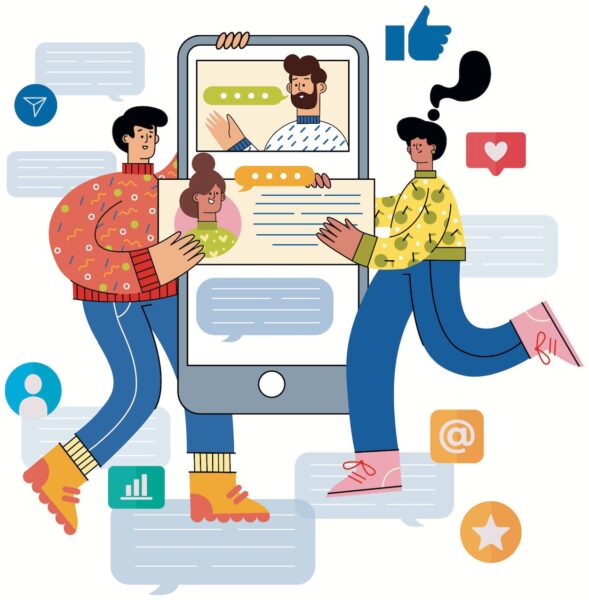 In a world awash in fake news and conspiracy theories, where people don’t trust the media, what can people do to combat misinformation and be more media-literate? COSMIC speaks to Trinna Leong on this.
In a world awash in fake news and conspiracy theories, where people don’t trust the media, what can people do to combat misinformation and be more media-literate? COSMIC speaks to Trinna Leong on this.
Trinna Leong is a media consultant. Formerly a journalist covering politics, economy and general news in Malaysia, Trinna’s reportage included MH370, MH17, the Rohingya boat crises, 1MDB,Kim Jong Nam’s assassination, Malaysia’s 14th General Elections, among others. Upon leaving journalism, she was the first South-east Asia Teaching Fellow at Google News Lab, running newsroom training to help journalists and editors skill up in the digital age. Now a media consultant, Trinna is designing and project managing programmes tied to media literacy work for Google News Lab, such as the Youth Verification Challenge and the annual Asia-Pacific Trusted Media Summit.
Let’s look at the news landscape and social media landscape. What are the challenges in the news landscape?
Most newsrooms, even established ones, are not innovating fast enough to attract more users. They struggle to keep up with what’s on the ground and are in the red.
Globally, there is a growing distrust of news and media that cuts across all generations. Many believe that media organisations are biased and aren’t neutral. They are often viewed as “pro-government” or “pro-opposition.”
So people turn to social media as the “alternate source of truth,” and trust what friends and family forward to them.
But there are many conspiracy theorists who generate material that are lies, which then circulate on social media. This is dangerous as lies repeated often enough become the “truth.”
For example, a famous figure in society can employ influencers (instead of putting out ads on traditional media) who reach out to the masses, and revise the truth about their background.
In an actual incident, a politician’s ill-gotten wealth was painted as inheritance. The same narrative was repeated for decades so many young people who are unaware of what happened in the past believed that the politician’s wealth is legitimate. With that history has been rewritten.
 What about the social media landscape?
What about the social media landscape?
I think we are generally aware of how people consume social media. The older generation would consume media over WhatsApp and Facebook, while young people no longer have Facebook accounts.
Many think that their social media feed is true, and even if they’re unsure, they’d still share rather than not. They’d think, “Better to share than to keep it to myself. If it’s true I could have helped someone.”
During the Covid-19 pandemic, misinformation on social media exploded. People shared unverified information on how to prevent or cure themselves of Covid-19, which includes consuming toxic chemicals. There is a couple in the US that were hospitalised because of following such “advice.” The husband eventually died while the wife was in critical condition. Misinformation can be very detrimental, even deadly.
People need to learn how to correctly consume and process information that they get through social media. In other words, a society that has critical thinking skills.
What can people do when they receive unverified or suspicious information, even from people they trust?
When you receive a forwarded media item, instead of just tapping “forward,” why don’t you just pause for a few seconds and think. Even better, use the next 30 seconds to do a quick web search.
You can just search about anything: whether a purported medicine is actually a medicine, or whether a phone number is actually a scam line.
People should pause and think about the item they receive, and ask “Is this true?” before deciding to forward them or not.
 What about graphics and videos?
What about graphics and videos?
For photos and other static graphics, you can look at them to see if there are visual clues such as identifiable landmarks and signs that can help identify the location, or even a logo or name on clothing.
For a video, you can listen to the language or accent in it: this can help tell you where it was actually shot and determine its authenticity. A video that claims to show an incident involving people of a particular Malaysian ethnic group could actually be from a neighbouring country where people have similar physical features as Malaysians.
For videos claiming to show “incidents” in Malaysia, you can check if the text on things like banners and speeches are actually in Malaysian languages. It’s very easy for people to recycle old images and videos and just put new captions on them – these are called “cheapfakes.”
Social media feeds can create bubbles or echo chambers that feed into our existing viewpoints. How can we break out of this?
The algorithms of social media platforms are built to feed you whatever you’re looking for. So if you’re looking for lies, you will be fed lies.
You have to start with the people around you, with your community. Taking sincerity and empathy as your starting point, try finding a common ground from which you can have a conversation where you could persuade them to look beyond the lenses or perspectives that they’ve been used to.
Please do not lecture them and say, “What you’re doing is wrong!” It doesn’t work.
 It’s about employing dialogue.
It’s about employing dialogue.
Yes. And it’s best to start with friends and family by talking to them. We can’t expect the government, some random organisation or strangers to talk to them, telling them what to do. In my work, we work with local grassroots organisations in the Asia-Pacific region, and they reach out to the people they know and educate them.
We train the volunteers and staff of the organisations, and they become the advocates on the ground. They’d speak to neighbours and local traders who believe in conspiracy theories, and share different types fof knowledge and tips on verifying information on their own, using empathy as a starting point.
If members of the public want to know more about or even take courses on media literacy, where can they go?
Unfortunately, there seems to be no long-term media literacy training platform in Malaysia. There are some that are specifically catered for educators, such as those run by Arus Academy. Sometimes there are one-off programmes that are operated by think-tanks or educators.
Don’t media companies invest in fact-checkers or content moderators to combat fake news and conspiracy theories?
Many don’t invest in fact-checkers and content moderators as it can be pretty costly. News organisations tend to either have in-house fact-checkers (this is a rarity), or ask their editorial staff to pick up basic fact-checking skills so they can step in and do simple checks when needed or worse, have a newsroom with zero fact-checking knowledge. Meanwhile, a large social media platform does hire third-party fact-checkers, but when the company’s algorithm feeds conspiracy theories to users, then this becomes an uphill task.
Fact-checkers just can’t fight the deluge of fake news and conspiracy theories. Further, they produce information in traditional formats that are not widely-consumed or only consumed by people who already believe them; in other words, they are preaching to the converted.
They too need to innovate, such as producing videos to cater for people outside their consumer circles, who don’t consume traditional media. They need to step outside their own “bubble.”
While the work of fact-checkers remains important, it is impossible to expect that all falsehoods can be debunked. It may be more sustainable in the longer term to educate everyone around us to consume information in smarter ways. If no one is falling prey to lies and sharing them, then these falsehoods on the internet wouldn’t have any space to feed on and eventually drop off the radar.
 How can people learn be unbiased and objective in a world that’s so polarised?
How can people learn be unbiased and objective in a world that’s so polarised?
In my work, we teach people the basics of fact-checking, and the knowledge they should have to recognise what’s true and false.
When people are unsure, rather than say, “This is right” or “This is wrong,” we’d say, “If you’re unsure, here’s what you can do to find out.” When approaching people who spread misinformation, you can’t reprimand them, especially family members.
Once again, it’s about approaching them from a standpoint of sincerity and empathy, and helping them to educate themselves about the impact of their actions and what can be done to change this behaviour.
Quick tip 1
You received a forwarded message of a miracle cure for a serious disease. True or false? How can you know?
– Don’t forward it first.
– Pause and think.
– Spend some time to do a web search. It’s only 30 seconds!
– True or false? If false, don’t forward!
 Quick tip 2
Quick tip 2
You received a photo or videos claiming to show a riot in Malaysia. True or false? How can you know?
– Look carefully for possible landmarks and signs that can help identify the location.
– Listen to the language and accents being used (for videos).
– Did the riot really take place in Malaysia? Did they use Malaysian languages?
– True or false? If false, don’t forward!
Quick tip 3
You have a family member who loves forwarding unverified information, and you’re frustrated. How can you stop them?
– Don’t reprimand them. It won’t work.
– Start with sincerity and empathy. Find a common ground to start a dialogue.
– Patiently educate them on the impact of their actions and what they can do to verify information they receive. A web search is the simplest and quickest.
– True or false? If false, don’t forward!
From the May 2023 issue of Cosmic


 In a world awash in fake news and conspiracy theories, where people don’t trust the media, what can people do to combat misinformation and be more media-literate?
In a world awash in fake news and conspiracy theories, where people don’t trust the media, what can people do to combat misinformation and be more media-literate?  What about the social media landscape?
What about the social media landscape? What about graphics and videos?
What about graphics and videos? It’s about employing dialogue.
It’s about employing dialogue. How can people learn be unbiased and objective in a world that’s so polarised?
How can people learn be unbiased and objective in a world that’s so polarised? Quick tip 2
Quick tip 2




